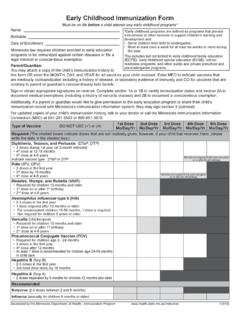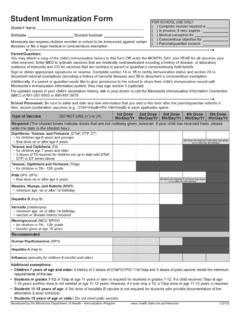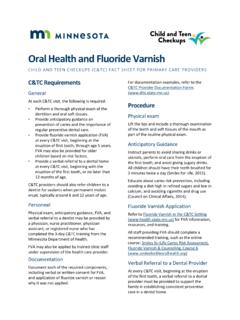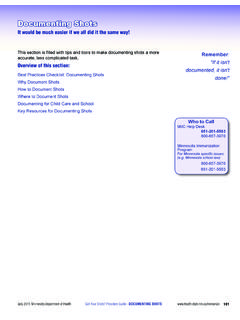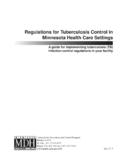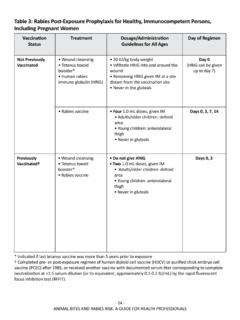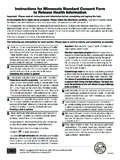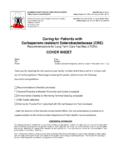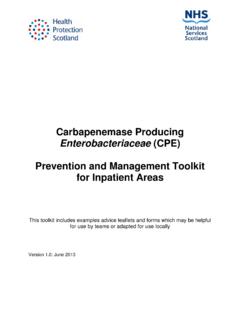Transcription of Recommendations for the Management of Carbapenem ...
1 2/2013 Recommendations for the Management of Carbapenem - resistant enterobacteriaceae (CRE) in Acute and long -term Acute Care Hospitals Minnesota Department of Health Recommendations for the Management of CRE in 02/2013 Acute and long -term Acute Care Hospitals Page 2 Infectious Disease Epidemiology, Prevention and Control Division Minnesota Department of Health 625 North Robert Street PO Box 64975 St. Paul, MN 55164-0975 Phone: 651-201-5414 Fax: 651-201-5743 TDD: 651-201-5797 Upon request, this material will be made in an alternative format such as large print, Braille, or cassette tape. Recommendations for the Management of CRE in 02/2013 Acute and long -term Acute Care Hospitals Page 3 Table of Contents Minnesota Department of Health.
2 1 Purpose .. 4 Classification and Epidemiology .. 4 Detection .. 5 Prevention .. 5 MDH CRE Infection Prevention and Control Measures for Hospitals .. 6 MDH Enhanced CRE Infection Prevention and Control Measures for Hospitals .. 9 CDC Guidance (2013) .. 10 MDH CRE Surveillance Activities .. 11 Additional Resources .. 13 References .. 14 Recommendations for the Management of CRE in 02/2013 Acute and long -term Acute Care Hospitals Page 4 Purpose These Recommendations are intended to provide: (1) infection prevention and control guidance for health care personnel in acute and long -term acute care hospitals in the Management of patients infected or colonized with Carbapenem - resistant enterobacteriaceae (CRE) and (2) resources and guidance for surveillance and laboratory testing, including Minnesota Department of Health (MDH) CRE surveillance definitions and requirements.
3 The infection prevention and control Recommendations were created to enhance rather than duplicate existing published Recommendations and guidelines for CRE control in acute care and long -term acute care settings. Literature reviews, the Centers for Disease Control and Prevention s (CDC) Guidance for Control of Infections with Carbapenem - resistant or Carbapenemase-Producing enterobacteriaceae in Acute Care Facilities, expertise from the Association for Professionals in Infection Control and Epidemiology (APIC) Emerging Pathogens Task Force, and discussions with national content experts served as the basis for the MDH will review the Recommendations regularly and modify them as needed to reflect new scientific developments concerning effective CRE prevention and control. Classification and Epidemiology The term CRE refers to Carbapenem - resistant and/or carbapenemase-producing enterobacteriaceae .
4 Over the past decade, enterobacteriaceae bacteria that are resistant to carbapenems have emerged and spread throughout the United States. Carbapenem antibiotics (ertapenem, imipenem, meropenem, and doripenem) are often used as the last line of treatment for infections caused by resistant Gram-negative bacilli (GNB) including bacteria in the enterobacteriaceae family. Multidrug- resistant GNB, such as CRE, are an emerging threat in healthcare facilities across the continuum of care ( , acute care, long -term acute care, and long -term care facilities). Currently, the most common carbapenemase in the United States is the Klebsiella pneumoniae carbapenemase (KPC). This plasmid-mediated carbapenemase is most commonly found in Klebsiella spp. and Escherichia coli but is also found in other species of enterobacteriaceae .
5 In 2009, upon detection of the first KPC-producing enterobacteriaceae in Minnesota, MDH began statewide passive surveillance for CRE. In 2010, two carbapenemases known as metallo- -lactamases (MBL) were first detected in the : New Delhi MBL (NDM) and Verona integron-encoded MBL (VIM).2,3 CDC reports a history of healthcare exposure in India or Pakistan has been reported in patients in whom NDM positive isolates have been detected. In late 2011, two isolates carrying the NDM resistance mechanism Recommendations for the Management of CRE in 02/2013 Acute and long -term Acute Care Hospitals Page 5 were detected in a single MN resident with a history of travel to and receipt of medical care in India. Plasmids and other mobile genetic elements are instrumental in the horizontal transmission of resistance genes such as KPC and NDM.
6 During 2011, MDH established active, population-based laboratory surveillance for CRE in Hennepin and Ramsey Counties to assess the population-based incidence of CRE and to better describe known resistance mechanisms. Detection Identification of CRE in clinical laboratories is based on the antimicrobial susceptibility values for carbapenems and third-generation cephalosporins. enterobacteriaceae that test non-susceptible ( intermediate or resistant ) to carbapenems and resistant to third generation cephalosporins are classified as CRE. Other tests, such as the Modified Hodge Test (MHT), can be utilized to identify carbapenemase ,5 Also available, but rarely performed in clinical laboratories, is polymerase chain reaction (PCR) testing for specific The PCR test identifies genes encoding for carbapenemases ( , blaKPC, blaNDM).
7 Regardless of the mechanism(s) responsible for CRE, infection prevention and control measures outlined in this document should be implemented upon detection of a CRE. Prevention MDH supports aggressive implementation of infection prevention and control strategies when a CRE is detected. Infections caused by CRE are difficult to treat and associated with high morbidity and ,8 Early detection and prompt implementation of infection prevention and control measures have been effective in reducing the likelihood of transmission in health care ,10 CDC and the Healthcare Infection Control Practices Advisory Committee also recommend an aggressive infection control strategy, including Contact Precautions for all patients colonized or infected with Prompt implementation of infection prevention and control measures requires close collaboration between clinical laboratory staff, infection prevention staff, clinicians, and nursing staff.
8 As part of this collaboration, it may be prudent for the clinical laboratory to share with infection prevention staff the complete antimicrobial susceptibility report for any CRE identified, including susceptibilities for carbapenems and third-generation cephalosporins, even if this information is routinely suppressed in the patient report. Recommendations for the Management of CRE in 02/2013 Acute and long -term Acute Care Hospitals Page 6 MDH CRE Infection Prevention and Control Measures for Hospitals For the Management of patients colonized or infected with a CRE, we recommend the following infection prevention and control strategies be implemented in addition to those included in your hospital s infection control policy/protocols for multidrug resistant organisms (MDROs).
9 Ensure that compliance with the MDRO policy is high among all staff interacting with the CRE positive patient and/or patient environment. This includes, but is not limited to: Isolation precautions, donning/doffing of appropriate personal protective equipment (PPE), hand hygiene, and environmental cleaning and 1. Laboratory testing Ensure the hospital laboratory is utilizing appropriate laboratory methods for detection of CRE (see MDH CRE Surveillance Activities). Adopt a standardized definition for CRE (see MDH CRE Surveillance Activities) and ensure the definition is being utilized by all departments including laboratory, infection prevention, and pharmacy, in addition to hospitalists and infectious disease physicians. Communicate positive CRE results immediately to infection prevention and staff providing patient care.
10 2. Patient placement Preferentially place patients with a CRE in a single room with Contact Precautions, or if no single room is available, cohort in the same room with another patient colonized or infected with CRE, regardless of species. 3. Laboratory retrospective review Infection prevention, in collaboration with the clinical laboratory, should conduct a one-time retrospective review (6 12 months) of laboratory records to identify previously unrecognized patients with This one-time retrospective review will serve as a baseline for your hospital and ensure proper processes are in place for prospective CRE surveillance. If previously unrecognized CRE positive patients are identified, conduct a single round of active surveillance testing (AST) of patients on units where these cases have been identified.

